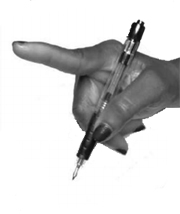BTX is secreted by the gram-negative bacterium Clostridium botulinum. There are seven subtypes of BTX, of which BTX types A, B and E are toxic to humans. BTX binds to peripheral cholinergic nerve endings at the neuromuscular junction and is incorporated into the neuron via endocytosis. As a result, the release of acetylcholine through the motor neuron is blocked at the synaptic cleft.
BTX A and BTX B are used to treat patients with different conditions, such as cervical dystonia, writer's cramp and blepharospasm. After intramuscular injection local muscle paralysis with (reversible) atrophy develops. Restitution of the activity at the neuromuscular junction occurs gradually, usually after twelve weeks, when new nerve endings have grown and made contact with the muscle membrane again.
Purpose of treatment with botulinum toxin
The goal of injecting botulinum toxin is to reduce the severity of the dystonia without causing side effects.
The main objectives of the botulinum toxin treatment are:
- reduce dystonic muscle contraction, causing improved position of the relevant body part
- reducing restriction of movement, caused by dystonia
- reducing pain in the affected area
- prevention of contractures and changes in joints, intervertebral discs or bone structures.
It is important to note that delay in starting treatment may lead to contractures and changes in joints, intervertebral discs, or bone structures1.
As with any treatment, it is important that the patient has realistic expectations of the botulinum toxin treatment. The patient must therefore be well be informed and realistic treatment goals should be formulated by the practitioner.
Types of botulinum toxin
Two types of BTX A products are available in South Africa:
Botox® (Allergan), onabotulinumtoxinA .
Dysport® (Ipsen), abobotulinumtoxinA.
Both BTX A products are supplied as lyophilized powder for intramuscular injection. The dose of BTX is described in International Units (IU), which is derived from the mean lethal dose in mice (LD50) after intra-abdominal injection.
A vial of Botox® contains 100 IU pure hemagglutinin complex (corresponding to approximately 6 nanograms of pure toxin).
A vial of Dysport® 500 IU hemagglutinin complex (equivalent to 12.5 nanograms toxin).
Patients may continue to derive benefit from treatment with botulinum toxin for up to 20 years from time of first treatment2.
Comparison of Botox and Dysport:
Despite more than 25 years of experience in using BTX A, there are a limited number of studies attempting to find the correct conversion factor. It is likely that Dysport and Botox cause a similar, significant decrease in muscle action potential (CMAP).
There is a lack of good comparison studies, so an accurate conversion factor is unknown, and that is likely to remain the case. A ratio of 1: 3.5 is likely the most accurate conversion3
|
Botox |
Dysport |
Botox |
Dysport |
|
|
5 units |
17.5 |
45 |
157.5 |
|
|
10 |
35 |
50 |
175 |
|
|
15 |
52.5 |
60 |
210 |
|
|
20 |
70 |
70 |
245 |
|
|
25 |
87.5 |
80 |
280 |
|
|
30 |
105 |
90 |
315 |
|
|
35 |
122.5 |
100 |
350 |
|
|
40 |
140 |
Shelf life botulinum
The potency of reconstituted Botox is not degraded by subsequent refrigeration for 4 weeks4.

